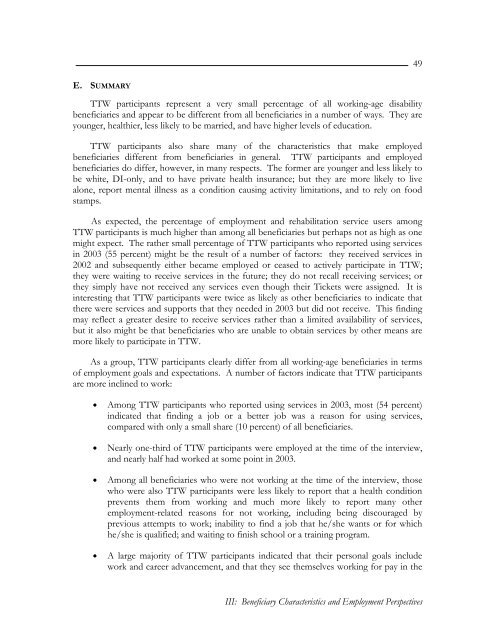Evaluation of the Ticket to Work Program, Implementation ...
Evaluation of the Ticket to Work Program, Implementation ...
Evaluation of the Ticket to Work Program, Implementation ...
You also want an ePaper? Increase the reach of your titles
YUMPU automatically turns print PDFs into web optimized ePapers that Google loves.
49E. SUMMARYTTW participants represent a very small percentage <strong>of</strong> all working-age disabilitybeneficiaries and appear <strong>to</strong> be different from all beneficiaries in a number <strong>of</strong> ways. They areyounger, healthier, less likely <strong>to</strong> be married, and have higher levels <strong>of</strong> education.TTW participants also share many <strong>of</strong> <strong>the</strong> characteristics that make employedbeneficiaries different from beneficiaries in general. TTW participants and employedbeneficiaries do differ, however, in many respects. The former are younger and less likely <strong>to</strong>be white, DI-only, and <strong>to</strong> have private health insurance; but <strong>the</strong>y are more likely <strong>to</strong> livealone, report mental illness as a condition causing activity limitations, and <strong>to</strong> rely on foodstamps.As expected, <strong>the</strong> percentage <strong>of</strong> employment and rehabilitation service users amongTTW participants is much higher than among all beneficiaries but perhaps not as high as onemight expect. The ra<strong>the</strong>r small percentage <strong>of</strong> TTW participants who reported using servicesin 2003 (55 percent) might be <strong>the</strong> result <strong>of</strong> a number <strong>of</strong> fac<strong>to</strong>rs: <strong>the</strong>y received services in2002 and subsequently ei<strong>the</strong>r became employed or ceased <strong>to</strong> actively participate in TTW;<strong>the</strong>y were waiting <strong>to</strong> receive services in <strong>the</strong> future; <strong>the</strong>y do not recall receiving services; or<strong>the</strong>y simply have not received any services even though <strong>the</strong>ir <strong>Ticket</strong>s were assigned. It isinteresting that TTW participants were twice as likely as o<strong>the</strong>r beneficiaries <strong>to</strong> indicate that<strong>the</strong>re were services and supports that <strong>the</strong>y needed in 2003 but did not receive. This findingmay reflect a greater desire <strong>to</strong> receive services ra<strong>the</strong>r than a limited availability <strong>of</strong> services,but it also might be that beneficiaries who are unable <strong>to</strong> obtain services by o<strong>the</strong>r means aremore likely <strong>to</strong> participate in TTW.As a group, TTW participants clearly differ from all working-age beneficiaries in terms<strong>of</strong> employment goals and expectations. A number <strong>of</strong> fac<strong>to</strong>rs indicate that TTW participantsare more inclined <strong>to</strong> work:• Among TTW participants who reported using services in 2003, most (54 percent)indicated that finding a job or a better job was a reason for using services,compared with only a small share (10 percent) <strong>of</strong> all beneficiaries.• Nearly one-third <strong>of</strong> TTW participants were employed at <strong>the</strong> time <strong>of</strong> <strong>the</strong> interview,and nearly half had worked at some point in 2003.• Among all beneficiaries who were not working at <strong>the</strong> time <strong>of</strong> <strong>the</strong> interview, thosewho were also TTW participants were less likely <strong>to</strong> report that a health conditionprevents <strong>the</strong>m from working and much more likely <strong>to</strong> report many o<strong>the</strong>remployment-related reasons for not working, including being discouraged byprevious attempts <strong>to</strong> work; inability <strong>to</strong> find a job that he/she wants or for whichhe/she is qualified; and waiting <strong>to</strong> finish school or a training program.• A large majority <strong>of</strong> TTW participants indicated that <strong>the</strong>ir personal goals includework and career advancement, and that <strong>the</strong>y see <strong>the</strong>mselves working for pay in <strong>the</strong>III: Beneficiary Characteristics and Employment Perspectives
















